#he gets a new handler and he cranks up the annoying by ten
Text


thinking abt how vanderwood was/is probably the one (1) informant that
could/can keep up with seven, and deal with his more 'annoying' traits.
#* && OOC#* && TBD#vanderwood has to get moved to another agent for w/e reason#and seven throws the BIGGEST fit about it. bc that's his bestie !!!#he gets a new handler and he cranks up the annoying by ten#he goes through a bunch of them in a few weeks bc they keep quitting and the agency doesn't wanna kill him because he's like#one of their top hacker dudes so. they just give vander back#fellas is it gay............. lmao#sorry i have brainrot
2 notes
·
View notes
Text
There’s nothing special about the Suns, which is why they’re succeeding

Phoenix is winning with an ordinary approach.
And that’s a really, really good thing.
Ten minutes into a press conference announcing his perennially dysfunctional franchise will hire its fifth head coach in the last four seasons, newly promoted Phoenix Suns general manager James Jones communicated his offseason plans about as clearly as one can.
“We need to add guys in their prime. We need to raise the floor of our team,” Jones said. “And you only do that with NBA players. Not prospects, but NBA players.”
As a rallying cry, “Raise the Floor” isn’t exactly “Trust The Process.” Still, it conveyed a specific message: we must walk before we can run, and the two aren’t mutually exclusive. Adding proven players wasn’t just a way for the Suns to avoid embarrassment. It’s the only way they could then take any next step.
That message didn’t break through in a summer where the Suns’ asset management ranged from adequate to baffling. It’s sure breaking through now as the Suns rise to the league’s third-best point differential in the very (very) early going of the 2019-20 season. They look like an actual basketball team, which is an incredible compliment given their recent past.
It’s difficult to find one specific reason for Phoenix’s surprising start. Outside of Aron Baynes turning into Splash Volcano, no Suns player has played well above their means. Their games aren’t really that exciting, unless effective screens and early rotations to the nail are your idea of appointment viewing. (Guilty.) One of their core young players is suspended until December, and the other is scoring and assisting less than he did last year. Their marquee free-agent signing is shooting 35 percent from the field.
But they’ve become a functional and possibly even good team precisely because they aren’t special. They’ve been bolstered not by top-level talent, but instead by the pristine positioning, floor spacing, and toughness from a crew of competent NBA role players. Or, as Jones put it, they’ve raised their floor.
“Aggressively competent” is how you’d describe recent additions like Baynes, Frank Kaminsky, Dario Saric, and Tyler Johnson. It’s how you’d describe Ricky Rubio at this stage of his career — consider that a good Jazz team let him walk to upgrade to Mike Conley. It’s how you’d describe 23-year-old rookie sharpshooter Cameron Johnson, selected way higher than anyone expected in the draft. It’s how you’d describe new coach Monty Williams, who slowly made the New Orleans Pelicans decent before they fired him to aim higher themselves.
The price for that aggressive competence wasn’t always ideal, but the total sum created a necessary baseline from which Phoenix is now building. The Suns’ early-season style of play is thoroughly unremarkable while also showing the power of executing a thoroughly unremarkable style of play effectively.
The Suns’ keep-it-simple ethos is most evident on defense. They do three things well and only three things well: pressure the ball, collectively pack the paint, and make second efforts if the first screen beats them.
Phoenix gets a lot of mileage out of being pains in the ass. Rubio is one of the NBA’s peskiest defensive point guards, but young wings Kelly Oubre and Mikal Bridges are also long and quick, while Saric never makes posting up pleasant. Even Booker, never known for his defensive energy, is blowing up dribble handoffs.

That ball pressure gets cranked up to 11 when backup point guard Jevon Carter enters. The days of the pitbull point guard defender that always seems to be in the opposing star’s grill are over, except in Phoenix, where Carter is relentless. Poor Tyus Jones needed 10 seconds just to get Memphis’ play going.

Ninety-four feetBall pressure is a life hack because it burns precious seconds off the shot clock, but you don’t see it much anymore for two reasons. One, it’s hard to defend physically without fouling. Two, it’s prone to backdoor cuts that ruin the system.
The Suns accept the first as a necessary tradeoff — they are dead last in the NBA in foul rate, which annoys Williams publicly, but probably not as much privately. They account for the second by aggressively rotating off perimeter players to pack the paint, especially when defending pick-and-rolls. The nail, which refers to a spot just above the free-throw line where an actual nail from the court’s structure peeks out, has become a second home for Suns perimeter defenders.
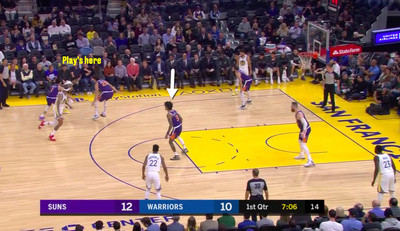
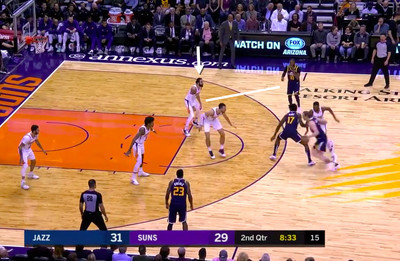
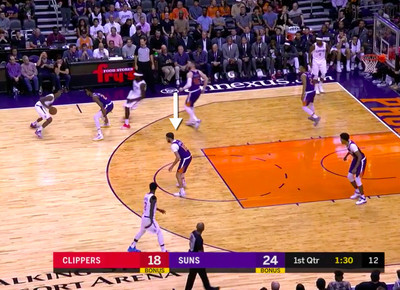
In theory, every NBA defensive scheme asks that help defender to stand on the nail to stop penetration. In practice, though, the nail defender is the one most stressed by the NBA’s spacing revolution. With the rise of the three-point shot and then the deep three-point shot, the nail defender is spread thin. It’s nearly impossible to plug rolls to the basket and also close out to their own man ready to fire from 27 feet. Worse, offenses have developed intricate tactics to distract that nail defender: switching two shooters along the three-point line, setting flare screens to delay closeouts, decoying a pick-and-roll to swing into another one, driving gaps instead of shooting, and many others I’m forgetting.
Phoenix’s early-season approach has vastly simplified those outcomes. Stopping dribble penetration is the only goal that matters, even at the expense of allowing spot-up three-pointers. That’s why you see Suns help defenders head to the nail before a pick-and-roll is even set, even if that may open up a shooter. They pre-rotate so they don’t have to rotate later.
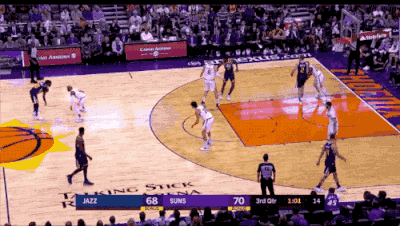
That strategy works in concert with the Suns’ other core tenant: keep their big men by the basket and stay vertical rather than trying to swat shots. In this respect, Baynes has been an essential addition. The 32-year-old, 6’10, 260-pound center, acquired in a draft-day salary dump with the Celtics, is physically imposing, precise, and unconcerned with recognition or embarrassment — the role player’s holy trinity. He’s made an eight-year NBA career out of standing near the basket and putting his hands up.
With him patrolling the back line, Suns players can pressure their men and collectively pack the paint. They can also recover to the roller when the initial screen beats them and gain credit for a steal or deflection — impressive hustle to be sure, but also effort that only gets rewarded because Baynes held up the ball-handler.

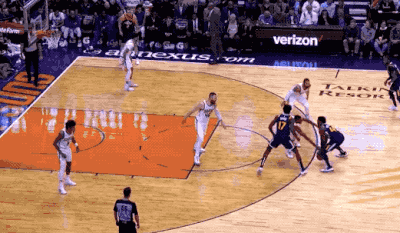
The Suns’ offense has also benefited from simplifying the operation. Williams preaches an “0.5 system” in which every decision should happen in half a second or less. The concept isn’t new or even especially novel. Prior Suns coaches Earl Watson and Igor Kokoskov used similar terminology with far less success. But the Suns now have a roster of floor-raisers who can actually embody its principles.
Simply adding Rubio, an adequate floor general, has made a huge difference after not having anything remotely resembling one last year. Rubio is the guy who keeps the rest of the players focused and gets Phoenix into its sets early to maximize the time they have to score. This preseason possession showed both skills on display.
7 Plays Or Less - Random Observations....
1. Want to see the impact Rubio's signing has on a team desperate for leadership? Watch him get to every player on the court after a bad transition D possession, that ended in Book/Ayton bickering.
The result? Highlight of the game. pic.twitter.com/ZeDVbx26wf
— Seven Seconds Or Less Podcast (@7SOLpod) October 9, 2019
Rubio also takes a huge burden off Booker, who has responded by channeling more energy into defense and reading the floor. His scoring is down, but he’s getting better shots and moving the ball more effectively when a shot isn’t there. He’s launching more often within a normal flow of the offense and less often when the shot clock is winding down and he needs to bail the Suns out. Fifty-six of Booker’s buckets are assisted this season compared to just 36 last year, and more than 45 percent of his shots have come off one or zero dribbles this year, compared to just 34 percent last season.
He also can do less because Phoenix’s new collection of floor raisers follow two important offensive rules: keep moving, and never roll into the paint if someone else is already there. Kaminsky and Saric always seem to be zipping around somewhere, like flies attracted to light. Both run the equivalent of at least a full mile on offense while playing fewer than 28 minutes, according to NBA.com’s player tracking stats. Only one other player 6’10 or bigger has done that this year, and only nine did so last season.


That movement is contagious because it tilts the defense and facilitates more motion from other Suns players. The Suns have scored directly from a cut on 9.4 percent of their possessions this year, second-highest in the league behind the Zombie Warriors. Oubre, a player not exactly known for his decision-making, has been a major beneficiary, as Bright Side of the Sun’s Brendon Kleen noted.
Crucially, Phoenix doesn’t allows two players in the paint at the same time, which would only shrink the space for each. Instead, their bigs often hang on the perimeter to open the lane for their wings to cut through. Baynes’ remarkable mid-career transformation into a giant flamethrower is especially important: he’s taking nearly seven threes per 36 minutes while hitting 46 percent of them, which is astonishing. Nowadays, he sets screens, chills at the line as his guards drive, and waits for the opposing center to either help too much on the ball-handler or, hilariously, cede a wide open shot for a way better teammate in fear of his own shooting.

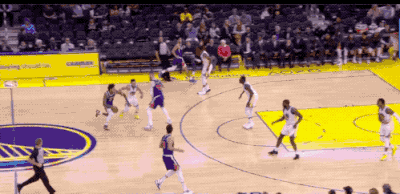
All of this is unremarkable, and that’s exactly the point. Protecting the paint? Good spacing? Proper positioning? Moving without the ball? These sound like prerequisites for NBA success, not bonuses. But the Suns haven’t taken any for granted, acquiring players who embody them and stressing a style of play that reinforces them. That’s a huge step considering how terribly they’ve built their rosters in the last decade.
Competence is not the same as brilliance, so don’t go printing those playoff tickets yet. In particular, I’m skeptical their defense will stay this elite once opponents realize their simple approach cedes open three-pointers. That’s already happening to some degree: the Suns are getting away with it largely because teams are only shooting 31 percent from downtown, which won’t happen over a full season.
In other ways, the Suns’ defense is getting a bit lucky. Opponent shot quality against Phoenix — which estimates the effective field goal percentage based on a model that considers the shot location and play context — is actually the fourth-worst in the league and more than five points higher than the actual effective field goal percentage the Suns are giving up. The incessant fouling will cost them more in the future, and it’s hard to see how they stop hacking when they are so physical with their ball pressure. Despite their pack-the-paint emphasis, the Suns also allow the sixth-highest percentage of shots at the rim, though they’ve effectively defended said shots so far.
But this is also the same organization whose owner brought live goats into his general manager’s office as a motivational ploy, only for them to shit everywhere in sight. Against that backdrop, competence will do just fine.
0 notes